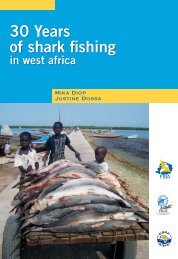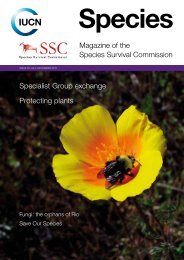Kyne & Simpfendorfer.. - Shark Specialist Group
Kyne & Simpfendorfer.. - Shark Specialist Group
Kyne & Simpfendorfer.. - Shark Specialist Group
You also want an ePaper? Increase the reach of your titles
YUMPU automatically turns print PDFs into web optimized ePapers that Google loves.
e slow to recover from overfishing. The population doubling times indicate that once a stock<br />
has been depleted, it will be decades, and potentially centuries, before it will recover.<br />
Fisheries that take deepwater chondrichthyans, both as targeted species or as bycatch, need to<br />
be carefully managed and should take a precautionary approach.<br />
Table 2.19. Intrinsic rebound potentials (r 1.5M , r 2M ) and population doubling times (T x2 ) for<br />
deepwater chondrichthyans with no increase in reproductive output (b) and with a 25%<br />
increase (1.25b).<br />
b b 1.25b<br />
Species r 1.5M T x2 r 2M T x2 r 2M T x2<br />
Squalidae<br />
Squalus blainvillei 0.0162 42.79 0.0312 22.23 0.0670 10.35<br />
Squalus megalops 0.0075 92.40 0.0144 48.07 0.0247 28.07<br />
Squalus mitsukurii 1 0.0086 80.69 0.0163 42.40 0.0273 25.35<br />
Squalus mitsukurii 2 0.0080 86.89 0.0153 45.30 0.0266 26.09<br />
Centrophoridae<br />
Centrophorus granulosus 0.0161 42.98 0.0278 24.96 0.0384 18.04<br />
Centrophorus squamosus 0.0070 99.53 0.0125 55.43 0.0175 39.66<br />
Deania calcea 3 0.0083 83.79 0.0155 44.85 0.0237 29.25<br />
Deania calcea 4 0.0076 91.66 0.0141 49.31 0.0218 31.73<br />
Etmopteridae<br />
Etmopterus baxteri 0.0071 98.13 0.0130 53.50 0.0187 37.02<br />
Somniosidae<br />
Centroselachus crepidater 0.0133 52.15 0.0230 30.20 0.0314 22.05<br />
Proscymnodon plunketi 0.0064 108.96 0.0119 58.35 0.0187 37.07<br />
Rajidae<br />
Amblyraja radiata 0.0149 46.39 0.0278 24.92 0.0457 15.18<br />
Leucoraja naevus 0.0371 18.69 0.0674 10.28 0.1100 6.30<br />
Raja binoculata 0.0163 42.50 0.0302 22.94 0.0450 15.39<br />
Chimaeridae<br />
Chimaera monstrosa 0.0202 34.35 0.0358 19.38 0.0508 13.63<br />
1 Ogasawara Islands, Japan, NW Pacific; 2 Hancock Seamount, NW Pacific; 3 Southeastern Australia;<br />
4 Rockall Trough and Porcupine Bank, NE Atlantic.<br />
The skates (families Arhynchobatidae and Rajidae) probably have the highest reproductive<br />
rates of any elasmobranch, with some species potentially producing hundreds of eggs per<br />
year. In the case of some species of Raja individual egg cases contain multiple eggs (Ebert<br />
and Davis 2007), increasing their fecundity. Despite these high reproductive rates, these<br />
species appear to be only reproductively active for a relatively short period of their life. Ebert<br />
(2005) reported that large (and hence older) female Bathyraja were senescent and so may<br />
only reproduce for a few years. This limitation on reproduction is likely to translate into low<br />
intrinsic rebound potentials as demonstrated by Leucoraja naevus which despite having an<br />
annual fecundity of 90, had a intrinsic rebound potential of 0.0371 yr -1 , due to a short<br />
reproductive life (Table 2.19).<br />
The intrinsic rebound potential values of deepwater chondrichthyan fishes fall at the lower<br />
end of the productivity scale of elasmobranchs, and include the lowest levels observed to date<br />
(Figure 2.1). Where the values of deepwater sharks fell within the range of continental shelf<br />
species they often had lower productivities for the same age at maturity. The values used in<br />
102
















